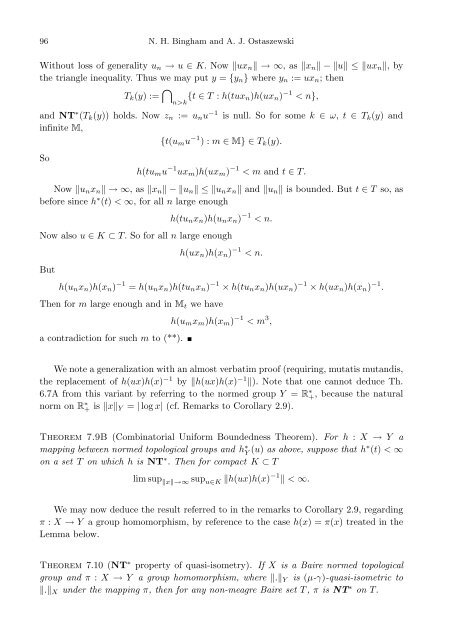Normed versus topological groups: Dichotomy and duality
Normed versus topological groups: Dichotomy and duality
Normed versus topological groups: Dichotomy and duality
You also want an ePaper? Increase the reach of your titles
YUMPU automatically turns print PDFs into web optimized ePapers that Google loves.
96 N. H. Bingham <strong>and</strong> A. J. OstaszewskiWithout loss of generality u n → u ∈ K. Now ‖ux n ‖ → ∞, as ‖x n ‖ − ‖u‖ ≤ ‖ux n ‖, bythe triangle inequality. Thus we may put y = {y n } where y n := ux n ; thenT k (y) := ⋂ n>k {t ∈ T : h(tux n)h(ux n ) −1 < n},<strong>and</strong> NT ∗ (T k (y)) holds. Now z n := u n u −1 is null. So for some k ∈ ω, t ∈ T k (y) <strong>and</strong>infinite M,{t(u m u −1 ) : m ∈ M} ∈ T k (y).Soh(tu m u −1 ux m )h(ux m ) −1 < m <strong>and</strong> t ∈ T.Now ‖u n x n ‖ → ∞, as ‖x n ‖ − ‖u n ‖ ≤ ‖u n x n ‖ <strong>and</strong> ‖u n ‖ is bounded. But t ∈ T so, asbefore since h ∗ (t) < ∞, for all n large enoughh(tu n x n )h(u n x n ) −1 < n.Now also u ∈ K ⊂ T. So for all n large enoughButh(ux n )h(x n ) −1 < n.h(u n x n )h(x n ) −1 = h(u n x n )h(tu n x n ) −1 × h(tu n x n )h(ux n ) −1 × h(ux n )h(x n ) −1 .Then for m large enough <strong>and</strong> in M t we havea contradiction for such m to (**).h(u m x m )h(x m ) −1 < m 3 ,We note a generalization with an almost verbatim proof (requiring, mutatis mut<strong>and</strong>is,the replacement of h(ux)h(x) −1 by ‖h(ux)h(x) −1 ‖). Note that one cannot deduce Th.6.7A from this variant by referring to the normed group Y = R ∗ +, because the naturalnorm on R ∗ + is ‖x‖ Y = | log x| (cf. Remarks to Corollary 2.9).Theorem 7.9B (Combinatorial Uniform Boundedness Theorem). For h : X → Y amapping between normed <strong>topological</strong> <strong>groups</strong> <strong>and</strong> h ∗ Y (u) as above, suppose that h∗ (t) < ∞on a set T on which h is NT ∗ . Then for compact K ⊂ Tlim sup ‖x‖→∞ sup u∈K ‖h(ux)h(x) −1 ‖ < ∞.We may now deduce the result referred to in the remarks to Corollary 2.9, regardingπ : X → Y a group homomorphism, by reference to the case h(x) = π(x) treated in theLemma below.Theorem 7.10 (NT ∗ property of quasi-isometry). If X is a Baire normed <strong>topological</strong>group <strong>and</strong> π : X → Y a group homomorphism, where ‖.‖ Y is (µ-γ)-quasi-isometric to‖.‖ X under the mapping π, then for any non-meagre Baire set T , π is NT ∗ on T.
















